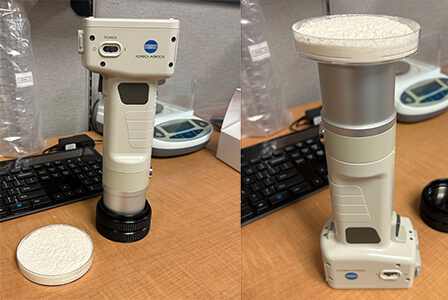Enhancing EV Battery Manufacturing with Colorimeters and Spectrophotometers
Understanding Colorimeters and Spectrophotometers:
Colorimeters and spectrophotometers are instruments designed to measure and analyze color. While both devices serve a similar purpose, they operate on different principles. Colorimeters are color instruments that perform “tristimulus” color measurement based on light passing through three primary filters (red, green, and blue), which simulate how the human eye is sensitive to light. Colorimeters can determine colorimetric values under a single illuminant and are used primarily for reflectance measurements. However, a colorimeter is inappropriate for complex color analysis such as metamerism, colorant strength, or recipe formulation.
Spectrophotometers are the most precise, accurate, and sophisticated color measurement instruments for color quality control and formulation. These instruments measure an object’s spectral reflectance (solid/opaque) or transmittance (transparent/translucent) across the full spectrum of visible wavelengths. A spectrophotometer has high precision and increased versatility. It is suitable for more complex color analysis because it can determine the spectral reflectance/transmittance at all visible or specific/designated wavelengths.
Common Use of Colorimeters in EV Battery Manufacturing:
- Quality Control
The color of cathode and anode powdered materials in EV batteries, especially lithium-ion batteries, can indicate their purity and composition. Consistent color is often a visual indicator of uniformity in manufacturing, ensuring that the materials meet specified standards.
- Identification and Classification
Different battery chemistries use various materials in cathode and anode powders, and the color of these materials can help identify and classify them during manufacturing, helping to ensure the correct materials for specific battery types.

The CR-410 (seen here with optional Granular Measurement Attachment) offers a larger measurement area of 50mm, perfect for cumulative color analysis of granular/powdered materials.
- Chemical Stability
The color of electrolytes and additives in EV batteries can provide insights into their chemical stability. Color changes may indicate chemical reactions or degradation, which can impact the overall performance and lifespan of the battery.
- Process Monitoring
Certain powders may undergo coating and deposition processes during manufacturing to improve their properties. Monitoring the color of coated materials can be crucial for ensuring uniformity in thickness and coverage, which affects the battery’s performance.
- Batch Consistency
Maintaining consistent color across batches of cathode, anode, and other powdered/granular components helps ensure uniformity in the manufacturing process. Any deviation in color may signal a variation in the composition or processing parameters that could impact the battery’s performance.
- Research and Development
In the research and development of new battery materials, manufacturers can use color as one of the parameters for characterizing and understanding the properties of the materials. It aids scientists and engineers in studying the behavior and stability of different materials under various conditions.
Spectrophotometers for Precise Color Analysis in Opaque Materials:
- Wavelength-specific Analysis
Spectrophotometers provide a more in-depth analysis by measuring light intensity at different wavelengths, allowing manufacturers to identify subtle color variations that may be invisible to the human eye. Benchtop spectrophotometers such as the CM-5 and CM-3700A Plus are great solutions for R&D labs, while portable instruments like the CM-17d are ideal for in-process/floor inspection.
- Coating Thickness Inspection
EV battery components often undergo coating processes to enhance their durability. Spectrophotometers aid in assessing the thickness and uniformity of these coatings, ensuring they meet the required specifications.
- Batch Consistency/Quality Control
Spectrophotometers play a vital role in maintaining batch-to-batch consistency during the manufacturing process. By precisely measuring color parameters, manufacturers can identify and rectify any deviations that may impact the overall quality of the batteries. Some instruments, such as the CM-26dG and the CM-36dG, offer simultaneous gloss measurements to ensure desired consistency further.
Spectrophotometers for Accurate Color Assessment in Transparent/Translucent Liquid Materials:
- Quality Control
Color is often an indicator of impurities, contamination, or variations in the composition of liquids used in battery manufacturing. Monitoring and controlling the color of liquids helps ensure the purity and consistency of materials, which is critical for the performance and longevity of EV batteries.
- Material Uniformity
Consistent color in liquids signifies uniformity in material composition. This is essential for achieving consistent performance across battery cells. Any deviation in color may indicate an uneven distribution of materials, potentially leading to variations in the battery’s electrical and mechanical properties. Benchtop instruments like the CM-5 and CM-36dG can offer transmittance measurements and reflective (opaque) as mentioned above.
- Chemical Reactions and Stability
Color changes in liquids can indicate chemical reactions occurring within the battery. Monitoring color helps identify any undesired chemical reactions that may affect the stability of the battery components. Ensuring a stable and uniform color in the liquids is crucial for maintaining the reliability of the battery over its lifespan.
Benefits of Incorporating Color Measurement Tools
- Improved Quality Control
Colorimeters and spectrophotometers enable manufacturers to implement stringent quality control measures, leading to consistently high-quality EV batteries.
- Increased Efficiency
By implementing color measurement processes, manufacturers can streamline their production lines, reducing the risk of errors, reducing rework/waste, and increasing overall efficiency.
- Enhanced Consumer Trust
Reliable color control ensures that EV batteries meet stringent quality standards, contributing to consumer trust and confidence in the brand.
In the swiftly changing electric vehicle battery production world, integrating colorimeters and spectrophotometers is proving to be a game-changer. Many companies plan to implement color measurement tools in their manufacturing processes. These instruments contribute to improving product quality and play a pivotal role in advancing the efficiency and sustainability of electric vehicles. As the electric vehicle industry continues to grow, the role of color measurement tools will likely become even more integral in ensuring the reliability and performance of EV batteries.
Want to learn more about color measurement in battery production, contact us for a quick discussion.
- Process Monitoring
Certain powders may undergo coating and deposition processes during manufacturing to improve their properties. Monitoring the color of coated materials can be crucial for ensuring uniformity in thickness and coverage, which affects the battery’s performance.
- Batch Consistency
Maintaining consistent color across batches of cathode, anode, and other powdered/granular components helps ensure uniformity in the manufacturing process. Any deviation in color may signal a variation in the composition or processing parameters that could impact the battery’s performance.
- Research and Development
In the research and development of new battery materials, manufacturers can use color as one of the parameters for characterizing and understanding the properties of the materials. It aids scientists and engineers in studying the behavior and stability of different materials under various conditions.
Spectrophotometers for Precise Color Analysis in Opaque Materials:
- Wavelength-specific Analysis
Spectrophotometers provide a more in-depth analysis by measuring light intensity at different wavelengths, allowing manufacturers to identify subtle color variations that may be invisible to the human eye. Benchtop spectrophotometers such as the CM-5 and CM-3700A Plus are great solutions for R&D labs, while portable instruments like the CM-17d are ideal for in-process/floor inspection.
- Coating Thickness Inspection
EV battery components often undergo coating processes to enhance their durability. Spectrophotometers aid in assessing the thickness and uniformity of these coatings, ensuring they meet the required specifications.
- Batch Consistency/Quality Control
Spectrophotometers play a vital role in maintaining batch-to-batch consistency during the manufacturing process. By precisely measuring color parameters, manufacturers can identify and rectify any deviations that may impact the overall quality of the batteries. Some instruments, such as the CM-26dG and the CM-36dG, offer simultaneous gloss measurements to ensure desired consistency further.
Spectrophotometers for Accurate Color Assessment in Transparent/Translucent Liquid Materials:
- Quality Control
Color is often an indicator of impurities, contamination, or variations in the composition of liquids used in battery manufacturing. Monitoring and controlling the color of liquids helps ensure the purity and consistency of materials, which is critical for the performance and longevity of EV batteries.
- Material Uniformity
Consistent color in liquids signifies uniformity in material composition. This is essential for achieving consistent performance across battery cells. Any deviation in color may indicate an uneven distribution of materials, potentially leading to variations in the battery’s electrical and mechanical properties. Benchtop instruments like the CM-5 and CM-36dG can offer transmittance measurements and reflective (opaque) as mentioned above.
- Chemical Reactions and Stability
Color changes in liquids can indicate chemical reactions occurring within the battery. Monitoring color helps identify any undesired chemical reactions that may affect the stability of the battery components. Ensuring a stable and uniform color in the liquids is crucial for maintaining the reliability of the battery over its lifespan.
Benefits of Incorporating Color Measurement Tools
- Improved Quality Control
Colorimeters and spectrophotometers enable manufacturers to implement stringent quality control measures, leading to consistently high-quality EV batteries.
- Increased Efficiency
By implementing color measurement processes, manufacturers can streamline their production lines, reducing the risk of errors, reducing rework/waste, and increasing overall efficiency.
- Enhanced Consumer Trust
Reliable color control ensures that EV batteries meet stringent quality standards, contributing to consumer trust and confidence in the brand.
In the swiftly changing electric vehicle battery production world, integrating colorimeters and spectrophotometers is proving to be a game-changer. Many companies plan to implement color measurement tools in their manufacturing processes. These instruments contribute to improving product quality and play a pivotal role in advancing the efficiency and sustainability of electric vehicles. As the electric vehicle industry continues to grow, the role of color measurement tools will likely become even more integral in ensuring the reliability and performance of EV batteries.
Want to learn more about color measurement in battery production, contact us for a quick discussion.










